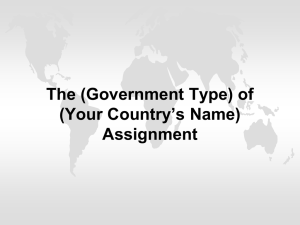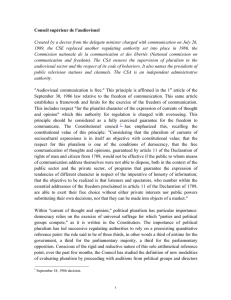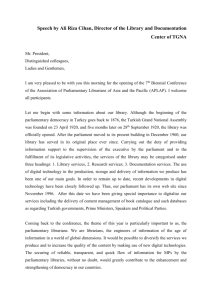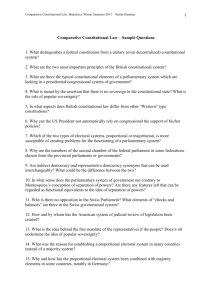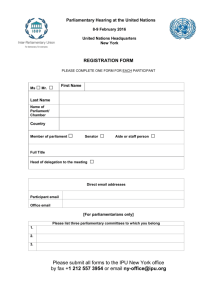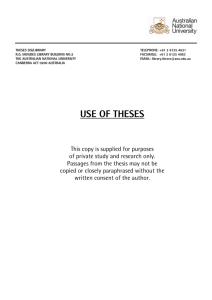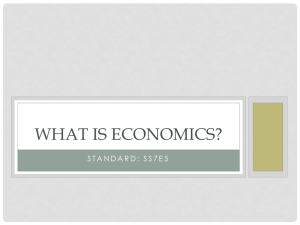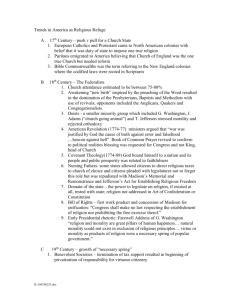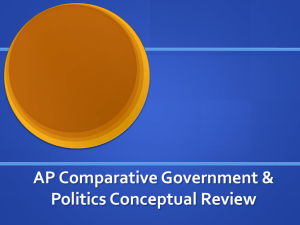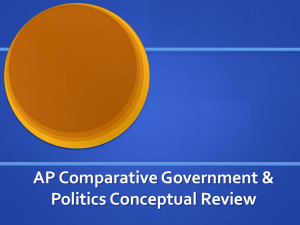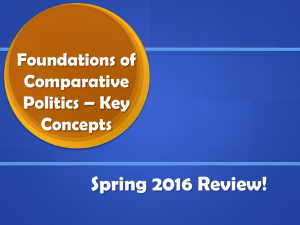Sample Final Exam
advertisement
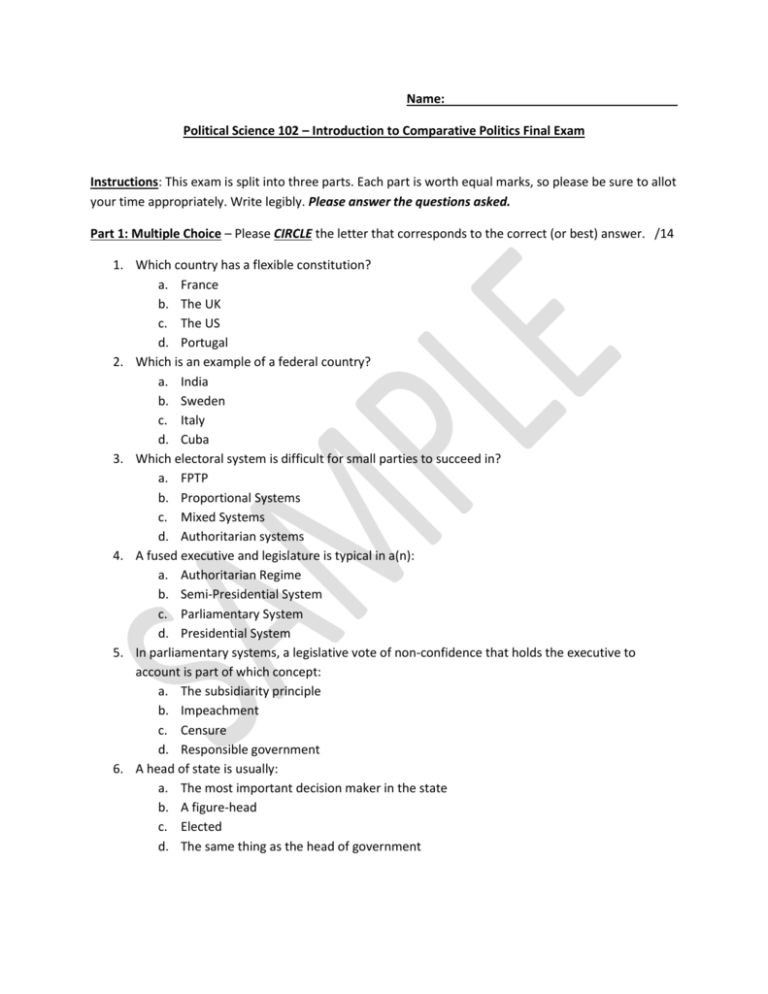
Name: Political Science 102 – Introduction to Comparative Politics Final Exam Instructions: This exam is split into three parts. Each part is worth equal marks, so please be sure to allot your time appropriately. Write legibly. Please answer the questions asked. Part 1: Multiple Choice – Please CIRCLE the letter that corresponds to the correct (or best) answer. /14 1. Which country has a flexible constitution? a. France b. The UK c. The US d. Portugal 2. Which is an example of a federal country? a. India b. Sweden c. Italy d. Cuba 3. Which electoral system is difficult for small parties to succeed in? a. FPTP b. Proportional Systems c. Mixed Systems d. Authoritarian systems 4. A fused executive and legislature is typical in a(n): a. Authoritarian Regime b. Semi-Presidential System c. Parliamentary System d. Presidential System 5. In parliamentary systems, a legislative vote of non-confidence that holds the executive to account is part of which concept: a. The subsidiarity principle b. Impeachment c. Censure d. Responsible government 6. A head of state is usually: a. The most important decision maker in the state b. A figure-head c. Elected d. The same thing as the head of government 7. Pluralism is a theory that emerged in the US in the 1960s so as to describe American democracy. What is the principle of pluralism? a. Politicians are elected to make the laws the voters would in their place b. Owners of the means of production have both unequal wealth and power. Therefore, we live in a world of class struggle c. There are numerous competing voices from which policy and power can emerge d. There are three voices (business, labour and government) where policy and power can emerge 8. Single-party dominant party systems are usually associated with: a. Democracies b. Authoritarian regimes c. Totalitarian regimes d. All of the above e. None of the above 9. Discrimination often emerges due to a. Biologically determined differences between people b. Warfare c. A poor trade relationship d. Socially constructed stereotypes 10. The process by which members of discriminated groups reclaim their political, economic and/or social power a. Empowerment b. Power struggle c. Interest groups d. Political parties 11. Which theory of international relations argues that we live in a world of global anarchy (circle 2) a. Realism b. Constructivism c. Liberalism d. Marxism 12. Stag hunt is: a. Another name for mutually assured destruction b. A model of game theory c. A model of Marxism d. A game you can buy for your phone. Why are you talking about Stag Hunt on a political science exam? 13. Advocates of realism argue that the Cold War was a. Good because a bipolar world, where each side can destroy each other leads to longterm political stability b. Competing interests worked together through institutions to reach a common good c. It allowed for the development of stereotypical narratives about either side to emerge d. The focus on two powers allowed for the emergence and economic growth of developing countries 14. Malapportionment of representation is a. Indicative of a poorly designed democracy b. Typical in federations to balance the interests of the whole population and regions or other interests in society c. The same as gerrymandering d. When powerful actors fail to ‘play by the rules of the game’ Pt 1b: Fill in the blank (you may use the appropriate letter) /7 1. _________________ is a concept that ensures that judges cannot overrule the legislature in constitutional matters. 2. _________________ is a non-proportional electoral system 3. _________________ is a political system defined by an extreme separation of powers 4. A ___________ coalition is one between the two biggest parties in the legislature 5. _____________ improving one’s economic, political or social standing after a period of discrimination 6. _______________ is a component of civil society often seeking to change people’s minds, rather than change policy 7. _______________is a party with flexible ideology and a large membership a. Unicameral b. pluralism c. The list system d. Mass parties e. catch-all parties F Parliamentary sovereignty g. First Past the Post h. empowerment i. interest groups j. Parliamentary k. congressional L. cabinet m. grand n. minimum winning o. social movement Part 1c: Matching – Please place the corresponding letter in the blank space provided /7 *NOTE: Your better score between part 1b and 1c will count, your lower score will not 1. 2. 3. 4. 5. 6. 7. Constitutional design in small countries a. Differentiated policy A legislature with two chambers b. Single Transferable Vote A Hybrid voting system c. Unitarism Distribution of population in a multiparty system d. Bicameralism An alternative to pluralism e. Corporatism When a state specializes its production f. Comparative advantage Giving disadvantaged groups more to make up for poor treatment g. Bimodal Part 2: Short Answer - Please answer any Four of the following questions: /4 X 4 1. 2. 3. 4. 5. What is the Tragedy of the Commons? What is a watershed moment? Provide an example. How does on determine a state’s party system? Why might a federation be more or less stable than a unitary government? What are the similarities and differences between constitutional monarchies and parliamentary republics? 6. Why might partisan powers of the executive be more powerful than those defined in the constitution? 7. What is judicial activism? How does it impact constitutions? Part 3: Long Answer – Please answer ONE of the following questions: /25 1. Compare and contrast the strengths and weaknesses of the different electoral systems discussed in the text and in class. Which is the most effective? 2. Compare and the contrast the strengths and weaknesses of the different theories of international relations we discussed in class. Which is the most convincing? 3. Some authors have argued that we are in the middle of a significant decline of democratic institutions in many Western countries, in part due to the rise of social media and instant gratification associated with engaging in activism online. Others argue that decline in party membership and political participation seen in most democracies is, in fact, compensated by a move of activism to these interest groups and, in fact, a positive development. Which argument is more convincing and, in either case, should people in democratic states be concerned? Why or why not?
